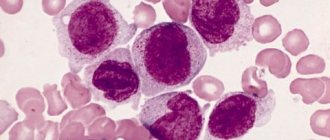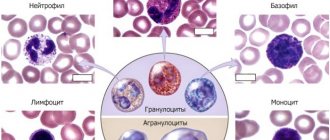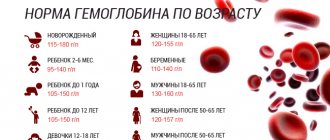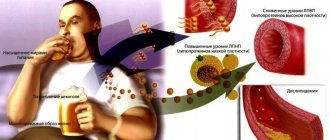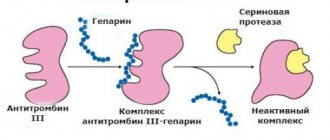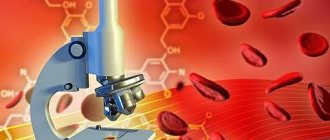Triglycerides are the most abundant type of fat, localized in specialized tissues of the body, distinct from cholesterol and its particular forms, HDL, LDL and other intermediates.
Any concentration deviations from the norm pose a health hazard. With a systematic and uncontrolled increase in triglyceride levels (abbreviated TG), the development of the so-called. atherosclerosis. A disease in which fatty compounds are deposited on the walls of the arteries. Plaques form, blocking the blood vessels and preventing the tissues from being nourished normally.
As a result, this leads to disastrous consequences: stroke, heart attack, dysfunction of the limbs up to necrosis, etc.
In all cases, early consultation with a doctor is necessary. At least an endocrinologist.
The role of triglycerides in the body
Several main functions of these fatty compounds can be identified. They are realized equally and at the same moment, constantly. While life processes are taking place.
Formation of new cells
Cytological structures are delimited from their external environment by a membrane. It is rigid enough to carry loads, allowing substances to selectively penetrate inward and compounds to be released outward.
The basis of the cytoplasmic capsule of the cell is cholesterol, as well as triglycerides (Triglycerides), which are what we are talking about. They act as a kind of building material, without which a cell cannot exist. Therefore, to say that the role of fatty compounds is purely negative is fundamentally wrong.
Problems arise only when there are deviations towards an unreasonable increase in indicators. In such a situation, you need to deal with the problem.
Ensuring the synthesis of sex hormones
If we consider triglycerides in a broader sense, as fats in general, then we can talk about this function of lipids.
They are also the raw material for the synthesis of testosterone in men and estrogens in women, thereby covering the needs of hormonal levels and ensuring normal reproductive function, as well as the functioning of the whole body. However, cholesterol is the basis here.
Energy exchange
The main task of triglycerides is to ensure normal nutrition of all tissues in the event of a deficiency of beneficial compounds in unforeseen conditions. To better understand the essence of the phenomenon, you need to know what is happening in the human body.
Lipids come from outside with products. The concentration of these varies and depends on the specific food. Next, the absorption of triglycerides begins in the small intestine.
When absorbed, these compounds adhere to specialized large cells, chylomicrons. These are transport structures. They move fats to the liver, where they begin to metabolize, turning into special acids.
Actually, they are stored in tissues, causing the notorious lipid deposits. Next, according to need, the body starts the process of breakdown or lipolysis.
Triglycerides are metabolized to ketones and glycerol, which provide alternative nutritional pathways to glucose throughout the body. The process proceeds in one direction. This is the main task of fatty compounds of this type.
The functions of triglycerides are few but extremely important. Therefore, it is necessary to adhere to an optimal diet so as not to exceed the concentration of lipids, but also not to provoke a deficiency of necessary compounds.
The issue of choosing the right nutrition is best left to the discretion of a nutritionist or, at a minimum, the same endocrinologist. In the absence of the opportunity to consult with a specialist doctor. These are already the tasks of treatment and prevention.
Elevated triglycerides in the blood of an adult man: what does this mean, reasons
Increased triglycerides in the blood
In men, starting from 18 years of age, the level of triglycerides in the blood is higher than in the fairer sex at this age. Some doctors are sure that this is due to poor nutrition, others claim that this is due to addiction to bad habits. So why are blood triglycerides elevated in adult men, what does this mean?
The reasons may lie in the following:
- Addiction to smoking.
- Constant consumption of strong alcoholic drinks.
- Overeating and eating fatty and fried foods containing bad cholesterol.
- Frequent stress.
Important: If you have had your triglycerides tested and your triglyceride levels are elevated, contact your doctor immediately. He will make a diagnosis, prescribe additional examination and adequate treatment.
Table of norms
Indicators gradually increase with age. Acceptable levels constantly tend to rise, which is due to the characteristics of metabolism in late periods of life and in the years of maturity. This is par for the course.
In addition, it is necessary to take into account the individual characteristics of a particular person’s body. Interpretation issues are dealt with by a specialist in the field.
Among women
The normal triglyceride level in women ranges from 0.41 to 2.73 mmol/liter. In the early stages of life and even in adulthood, the rates are lower. The basis for such differences is hormonal levels.
Only closer to menopause does a more or less noticeable equalization of lipid concentration begin. Detailed data by age is given in the table:
| Age (years) | Normal triglyceride levels in mmol per liter |
| Up to 15 | 0.41-1.45 |
| 16-20 | 0.42-1.48 |
| 21-25 | 0.42-1.48 |
| 26-30 | 0.42-1.62 |
| 31-35 | 0.42-1.48 |
| 36-40 | 0.45-1.70 |
| 41-45 | 0.45-1.97 |
| 46-50 | 0.51-2.15 |
| 51-55 | 0.59-2.65 |
| 56-60 | 0.59-2.69 |
| 61-65 | 0.62-2.70 |
| 66-70 and older | 0.63-2.73 |
The figures are approximate. Averaged. In reality, deviations in one direction or another are possible. The results must be interpreted by a specialist.
In men
The permissible norms of triglycerides in men are 0.36-2.95 mmol/l, which is initially slightly higher, because the breakdown of fats does not occur so quickly, and the reason for this is hormonal. But stockpiling is carried out much more actively. This is an evolutionarily determined feature.
| Age | Normal triglyceride levels (mmol/liter) |
| Up to 15 | 0.36-1.42 |
| 16-20 | 0.45-1.82 |
| 21-25 | 0.50-1.26 |
| 26-30 | 0.52-1.81 |
| 31-35 | 0.55-3.00 |
| 36-40 | 0.65-3.63 |
| 41-45 | 0.65-3.63 |
| 46-50 | 0.53-3.70 |
| 51-55 | 0.65-3.61 |
| 56-60 | 0.62-3.25 |
| 61-65 | 0.65-3.28 |
| 66-70 and older | 0.62-2.95 |
It must be borne in mind that reference values (range of norms), as well as calculation methods, may differ in different clinics. Therefore, you should not rely on independent decryption.
Attention:
Indicators should be considered as a system, not in isolation. To draw conclusions on the state of health and the quality of lipid metabolism, it is necessary to evaluate a group of levels. Otherwise, serious mistakes will inevitably occur.
How to increase triglyceride levels in the blood?
Increasing TG levels
Triglycerides are an important lipid that is involved in the body's fat metabolism and energy metabolism. If it is elevated, there may be problems. But it happens that its level decreases. What should you eat and drink, what diet should you follow in order to increase the level of triglycerides in the blood? It is worth noting the following:
- Reduced TG can occur when there are any disturbances in the body system.
- If the indicator is up to 0.30 mmol/l , this indicates an underestimated lipid level.
- Most likely, you are experiencing a lack of fat intake into your body, or there are problems with its absorption.
- Some processes in the body may slow down.
How to increase triglycerides? There are ways to restore metabolism:
- You need to pay attention to how much and what you eat . It is advisable to eat often, but in small portions.
- Physical activity (without fanaticism) and increased physical activity will also help.
- Bath procedures are also an important element of treatment . You don’t need to get too carried away with them, but the bathhouse really does heal.
- You should drink as much water as possible . If you drink warm water, it will also cleanse your intestines and the body as a whole of toxins.
Advice: You should avoid heavy foods. If fatty and fried foods, and even in large quantities, enter the body, it ceases to cope with it normally. Fat begins to enter the bloodstream, envelop internal organs, and this leads to the development of various pathologies.
Doctors advise eliminating foods that can cause diarrhea from your diet:
- Dairy products
- Products made from premium wheat flour
You can include dietary supplements with various beneficial elements in your diet:
- Magnesium
- Calcium
- Iron
- Vitamins are also useful
You can use special enzymes that improve the condition of the pancreas in order to compensate for their deficiency. At the same time, you need to take measures to restore your appetite, cook those dishes that you like, but not fatty or fried. Spices can be used in cooking.
Natural causes of TG growth
An increase in the concentration of triglycerides and TG in the body does not always have pathological, pathogenic development factors. However, these are the majority.
If we talk about the minimum number of exceptions, they almost always have a nutritional origin in one way or another.
- Consuming large amounts of foods high in animal fat. Meat, especially red meat, and other foods. Artificial products and those that have been subjected to multiple processing are extremely harmful.
For example, fast food, semi-finished products with questionable production technology. To correct deviations, it is enough to give up junk food and normalize your own diet.
- Long-term adherence to a strict diet with low calories and insufficient nutritional value as a cause of elevated triglycerides occurs most often in women. Also in persons with complex diseases, with prolonged immobilization and other factors.
If such a patient begins to eat actively after recovery, there is a high probability that the body, at the level of cellular memory, will begin to more actively store fats.
This will not lead to anything good. It is necessary to gradually adjust the diet and introduce new products into it. Otherwise, a sharp jump in body weight and triglyceride concentrations cannot be avoided.
- The change also occurs during peak hormonal states. Since they are not diseases, they cannot be classified as pathological. Puberty, puberty, pregnancy, the proximity of the menstrual cycle, its active phase, as well as the early stages of the transition to menopause are identified as the reason for the increase in TG concentration. When reproductive function fades, a person enters a stage of low hormonal levels.
There is usually no need to do anything special. If dangerous changes develop, treatment is prescribed according to the profile.
Triglycerides (TG) - above normal
High triglycerides (TG) in the blood lipid profile can indicate to doctors the risks of diseases such as atherosclerosis, diabetes mellitus, pancreatitis (chronic or acute / for complications of AP), “fatty liver”, liver cirrhosis, hypertension, coronary heart disease (coronary artery disease) , renal failure (chronic). They also directly indicate a previous myocardial infarction, increased risks of developing cerebral thrombosis, obesity, and gout. In addition, TG levels (much higher than normal) can be observed in people suffering from alcoholism.
We recommend checking out (links below):
- high TG levels - what does this mean, what are the reasons for the increase?
- how to quickly and effectively reduce TG levels in the blood? (detailed material)
- medications that increase cholesterol and triglyceride levels in the blood
- medications (tablets, capsules, injections) to reduce their concentration in the blood
It is definitely worth noting that elevated triglyceride values can be detected specifically in women during pregnancy, during menopause (menopause), after taking birth control pills, or during hormonal therapy (especially while taking oral estrogens). And finally, they point to a purely female disease - PCOS (polycystic ovary syndrome).
Also read about WHAT DO HIGH TRIGLYCERIDES MEAN FOR WOMEN?
Pathological factors
Diabetes
Classic pathology of the endocrine type. Accompanied by a violation of insulin synthesis or a decrease in the body’s sensitivity to it and its tissues.
Then, for this reason, the concentration of glucose in the blood increases. The final result of the development and existence of the process is the inability to ensure normal metabolism. Which leads to critical disorders of all body systems.
Lipid metabolism is primarily affected. It needs to be corrected as quickly as possible. Since atherosclerosis is the scourge of diabetics and one of the reasons for the formation of complications that provoke disability.
Pathologies of the cardiovascular system
It is difficult to say what is the cause and what is the effect. As a rule, hypertriglyceridemia is secondary. Because at the initial stage cholesterol levels change. Then the cardiac structures are involved. And only then, as a result of a complex disorder of the whole body, an increase in the levels of other fats is observed. In this case, we can already talk about the tertiary nature of the pathological process.
Liver disorders
A common cause of elevated triglycerides is liver disease from hepatitis and birth defects to cirrhosis and cell death. Since the largest gland in the body is responsible for metabolizing and processing fats, any deviations immediately result in metabolic disorders.
How pronounced and dangerous depends on the primary diagnosis. In some cases, pathological processes are asymptomatic, and they can only be suspected based on the results of a blood test with an expanded lipid profile.
In any case, treatment of liver diseases should begin as quickly as possible, before a persistent process develops and dangerous complications begin.
Inflammation of the pancreas or pancreatitis
Accompanied by a gradual increase in triglyceride concentration. This happens due to enzymatic deficiency. Without specific substances synthesized by this organ, there cannot be normal metabolism.
After recovery, a correction of TG levels is observed, but not fast, but equally gradual. At the same time, if there is a chronic inflammatory process, there is a high probability of persistently elevated triglyceride levels, which is dangerous and requires correction. The main problem is timely identification of the source.
Thyroid disorders
If triglycerides are elevated, this may mean a drop in the concentration of specific hormones: T3, T4, and less commonly, pituitary TSH.
A similar scenario is inevitable when the organ is hypofunctioning, since it works as a kind of “conductor” of the entire endocrine system. Indirectly responsible for metabolism, absorption, storage and breakdown of fats. Therefore, it is necessary to begin treatment quickly. The longer the primary process exists, the higher the risks.
Uric acid metabolism disorder
Hyperuricemia (increased uric acid in the blood) is a significant factor in the development of the problem under consideration.
Use of certain drugs
Although this moment cannot be called strictly pathological, and it can be easily corrected on your own. We are talking about medications such as diuretics, beta blockers, some drugs for the treatment of hypertension, as well as antipsychotics.
The possibility of a negative impact will be better explained in the annotation for a specific product; such factors must be indicated by the manufacturer.
This reason for the increased concentration of triglycerides is simple, and the correction is very clear: replacing or eliminating the medication that caused the problem.
Long-term smoking, excessive consumption of alcoholic beverages
Bad habits also provoke a chronic increase in triglycerides. With a decent amount of experience, refusal alone is clearly not enough. Additional measures will be required. Including medications, under the supervision of specialists. Mainly in endocrinology.
There are other, but more rare, reasons for the development of the process. For example, kidney disorders, etc.
The issue of identifying the culprit lies in the field of diagnostics. If the level of triglycerides is higher than normal, they first look for pathological factors, only then can natural factors be identified. By exclusion method.
How to control TG levels
An increase in triglyceride concentrations, which is called hypertriglyceridemia, remains asymptomatic for a long time. The first signs develop already when the disease is advanced. For this reason, it is important to take a blood test for neutral fats and cholesterol once every 4-6 years from the age of 20. It has been proven that an increase in their level is a harbinger of cardiovascular diseases.
Due to the lack of estrogen protection, men are susceptible to early coronary heart disease, heart attacks, and strokes. Special risk groups include:
- smokers;
- alcoholics;
- inactive men;
- overweight;
- patients with diabetes mellitus, kidney diseases;
- all people whose diet contains excess sugars and fats.
These people are advised to have their blood tested more frequently.
Typically, triglyceride levels are determined together with cholesterol, LDL, HDL, and VLDL. This comprehensive analysis is called a lipid profile. Blood is drawn from a vein. No special preparation is needed before the study; it is enough to follow the standard rules for biochemical analysis:
- blood is donated strictly in the morning on an empty stomach, from 8 to 10;
- it is necessary to follow a fasting diet for 12-14 hours;
- in case of thirst, the only drink allowed is water;
- 1 hour before the test, you should not smoke, move actively, or be nervous;
- It is advisable to take a sitting position 5 minutes before blood sampling.
Analysis of triglycerides is also indicated for people with a clinical picture of coronary artery disease, heart disease, brain disease, and diabetes mellitus to determine further treatment strategies.
Reasons for the decline
This is somewhat less common. But it does happen. In what cases does it develop?
- Malnutrition. Again, the nutritional factor. We are talking about a banal nutritional deficiency. There is simply nowhere to metabolize fats. The phenomenon is observed with a relatively long-term lack of food. It is especially common in malnourished patients.
- Pathologies of the digestive tract. Primarily the intestines. A decrease in the concentration of triglycerides is possible if the absorption of compounds is impaired. However, this is usually not reflected in blood counts. But there are exceptions.
- Liver disorders. Also a common reason. Violations are different in nature and, depending on their essence and diagnosis, certain problems are possible. A decrease in triglyceride levels means that the function of the largest gland is significantly impaired, and the more serious the disorder, the lower the indicators. The correlation is direct.
- Increased levels of thyroid hormones in the bloodstream. Hyperthyroidism. Fats are processed too quickly and turned into energy for no good reason.
If the content of triglycerides in the blood is increased, this means that the disorder is likely to be of a purely metabolic nature, a functional type, while a decrease most likely indicates organic, serious problems. We need to understand in more detail.
Reasons for the increase
A change in indicators to a lesser or greater extent certainly indicates violations that occur in the human body.
The main reasons for a decrease or increase in triglycerides in the blood are given in the table below.
| Promotion | Decrease |
| · Excessive excess weight; | · Insufficient body weight; |
| · Insufficient production of thyroid hormones; | · Chronic lung pathologies; |
| · Diabetes; | · Increased production of thyroid hormones; |
| · Liver pathologies and urinary tract disorders, which lead to stagnation of bile in the liver. These are viral hepatitis and blockage of the bile ducts; | · Burns and traumatic situations; |
| · Pathologies of the heart and blood vessels (atherosclerotic processes, high blood pressure, cardiac ischemia); | · Consumption of vitamin C and fish oil; |
| · Increased uric acid levels; | · Heart attack; |
| Inflammation of the pancreas; | · Insufficient production of lipoproteins; |
| · Kidney pathologies; | · Improper absorption of nutrients by the gastrointestinal tract; |
| · Use of certain types of medications (corticosteroids, diuretics, beta blockers); | · Vegetarian diet. |
| · Alcoholic drinks and cigarettes. |
In most cases, the study of triglycerides is not carried out separately, but is determined when submitting a lipid profile, which includes HDL, LDL, LDL, total cholesterol (TC) and atherogenic coefficient (AA).
Only based on the ratio of all these indicators can developing atherosclerosis be determined.
The main reason for elevated levels of triglycerides in the blood is an unhealthy diet containing large amounts of fatty foods. Excess food consumed is deposited in adipose tissue in the form of triglycerides, which break down into fatty acids and glycerol.
This process helps the body make “reserves” in case of extreme conditions for it.
It is important to understand that an increase in triglycerides is not a pathological prerequisite for the development of an atherosclerotic process.
The disease is triggered by an imbalance between “good” and “bad” cholesterol.
If you express a desire to become a donor, you will need to follow a low-cholesterol diet several days before the study, since biological material with a high level of fat content is not suitable for transfusion.
Elevated levels of triglycerides in the blood are caused by poor diet.
Additional examinations
Diagnosis is carried out under the supervision of endocrinologists. The minimum program includes the following activities:
- Oral questioning of the patient regarding complaints. It is necessary to evaluate all possible symptoms and create a single, understandable clinical picture from them. This will allow you to put forward hypotheses.
- Anamnesis collection. That is, those factors that could become the source of the problem. For example, lifestyle, past illnesses, family history and other significant points.
- Biochemical blood test with an expanded picture of lipids. The bold spectrum allows you to consider all levels in the system, this is important when carrying out basic and differential diagnostics.
- Ultrasound of the abdominal organs. To assess the condition of the structures of the digestive tract.
More specialized activities can be carried out as needed. Be it MRI or FGDS, other procedures.
Basically, this turns out to be enough. Everything else is the prerogative of the specialist conducting the examination.
Cholesterol and triglycerides are elevated: what does this mean?
Cholesterol and triglycerides are increased
Triglycerides are fatty substances that consist of acids and alcohol. As a person ages, cholesterol levels increase. And therefore, regular checking of cholesterol levels is a common procedure. In addition to cholesterol, you need to check your triglyceride levels. High triglyceride levels lead to many diseases.
Remember: Elevated TG levels alone, without other risk factors, put a person at risk for developing heart and vascular disease.
Often patients with high TG levels see low HDL (this is good cholesterol) in the analysis. But despite this, there is a risk of developing heart pathologies.
Important: If both cholesterol and triglycerides are elevated, this means you need to go to the doctor. Please contact your physician with the test results.
He will decipher them, make a diagnosis and, if necessary, prescribe an additional examination or recommend a consultation with another more specialized specialist, for example, a cardiologist or endocrinologist.
Methods for reducing triglycerides
Therapy is carried out based on the underlying cause. There is no point in reducing or increasing indicators in isolation from the problem, and there is no opportunity as such. Medication methods are used.
- Liver diseases are eliminated through diet and with the help of hepatoprotectors. Essentiale, Karsil as examples. Cirrhosis in advanced stages requires organ transplantation.
- The use of medications that provoke a disorder makes only two solutions possible: withdrawal or replacement of names.
- Diabetes requires strict monitoring of glucose levels. Insulin is used as needed.
- Natural processes do not require correction; everything returns to normal on its own.
In most cases, a change in diet plays a key role: it is necessary to minimize the amount of animal fat, and if TG levels are low, increase the consumption of Omega-3, 6, preferably in the form of specialized food supplements.
A balanced menu needs to be drawn up with a doctor; there is no point in using average calculations - they may not be suitable in a particular case.
Causes of high and low triglyceride levels
Elevated triglycerides can be the result of an unhealthy lifestyle. Obesity, smoking, alcohol abuse, a diet rich in bad fats, and lack of physical activity are the main factors for hypertriglyceridemia in young women. In this case, a high concentration of neutral fats acts as a marker of the risk of cardiovascular diseases.
Also, an increase in TG levels is accompanied by a number of pathologies:
- hereditary hyperlipidemia (types I, III, III, IV, V, apolipoprotein C-II deficiency);
- inflammation of the pancreas;
- liver pathologies;
- thyroid insufficiency;
- nephrotic syndrome;
- kidney diseases;
- gout;
- diabetes;
- Gierke's disease;
- anorexia nervosa;
- Down syndrome.
The reason for the decrease in triglyceride levels may be prolonged fasting or constant weight loss. In addition, hypotriglyceridemia is a symptom of certain diseases:
- abetalipoproteinemia;
- hyperfunction of the thyroid and parathyroid glands;
- malabsorption;
- chronic obstructive pulmonary disease.
The concentration of neutral fats changes while taking medications. Beta blockers, catecholamines, cyclosporine, corticosteroids, diuretics, diazepam, interferon, estrogens, miconazole, retinol increase their levels, and vitamin C, aminosalicylic acid, fish oil, prazonin, asparaginase, heparin decrease them.
Prevention
Measures to maintain normal triglycerides are available to the patient himself:
- To give up smoking.
- Elimination of alcohol.
- Consumption of animal fat within reasonable limits.
- Timely treatment of all diseases.
- Regular examinations at least by a general practitioner with general and biochemical blood tests.
Triglycerides in the blood are specific fats; their content can be used to judge the nature of metabolism. All deviations must be checked. If necessary, treatment is prescribed. A timely approach allows you to cope with the problem and avoid consequences.
What are triglycerides?
Triglycerides (abbr. TG) or triacylglycerides (abbr. TAG) are complex compounds (esters) of glycerol (trihydric alcohol) and fatty acids (also, as a rule, three - hence the prefix “THREE”). They are a priority “capacity” for the accumulation of fatty acids that are important for the body, as well as one of the most important sources of energy for humans (representing an alternative / “safety” version of glucose, i.e. when its reserves are depleted).
Triglycerides (fats) are very important for our health (having many vital/essential properties), but in excess they are harmful! Increasing the risks of developing cardiovascular diseases, atherosclerosis
, pancreatitis, diabetes, fatty liver and hypertension. However, their reduced level is considered no less alarming, indicating other problems with our health (more on this later in this article).
Triglycerides - macro photography
One of the main reasons for elevated levels of triglycerides in the blood is a large number of unspent calories (so-called “energy” units), which our body stores in the form of TG (as an “energy” reserve for the future). Thus, if you eat too much high-calorie/fatty foods and lead a sedentary/active lifestyle, this will certainly lead to an increase in the amount of “extra” (unclaimed) triglycerides!
Triacylglycerides are “transported” in the blood, being part of very low density lipoproteins (VLDL) or chylomicrons (CM). The main function of the latter is the transfer of dietary (i.e. food) triglycerides / exogenous fats (coming to us with food) from the small intestine (where they are absorbed) into the bloodstream (via lymphatic vessels). However, a much larger amount of TG, nevertheless, does not come to us with food, but is synthesized in the liver (these are endogenous fats), from where, in the protein shell of VLDL, they “go” to the cells along the highways of the circulatory system.
Triglycerides: what are they? norm for men and women
Fats... How much effort people spend on fighting them, without even realizing their purpose.
But there are harmful, healthy and even neutral types of lipid fats. Triglycerides are lipids that are neutral in nature. They are a source of energy for humans. But everything should be in moderation. In this article you will learn in more detail: what triglycerides are, their work responsibilities in our body, when they test for triglycerides in the blood and what their deviations from reference values indicate.
Triglycerides - what are they?
Triglycerides are organic compounds derived from glycerol and fatty acids. These neutral lipids are necessary for the body to provide energy to cells.
They enter the body, like all strategically important components, along with food. The main sources of triglycerides are vegetable and animal fats.
When lipids enter the body, the process of fat metabolism begins:
Chylomicrons (large lipoproteins) act as a means of transportation throughout the body. It is to them that triglycerides go after the small intestine.
After all the “passengers” are collected, lipoproteins travel throughout the body, first through the lymphatic vessels, and then into the blood. In the blood, chylomicrons are broken down. As a result, fatty acids are formed. They penetrate muscle and fat tissue.
In the liver, fatty acids, together with carbohydrates, are again converted into triglycerides, which are called endogenous.
The well-known cholesterol is inextricably linked with neutral lipids. Both elements are determined during a biochemical blood test.
It is worth noting that there are 2 types of cholesterol:
- HDL (HDL) – has a positive effect on the body, its level should be higher,
- LDL (LDL) – “bad”. High levels can lead to an increase in glycerol in the body.
Functions in the body
The functional purpose of triglycerides is protection and energy supply. At their core, they are a source of energy for tissues, as well as a store of energy. Fat has very low thermal conductivity, so it protects against the cold.
playerhttps://kardiobit.ru/wp-content/uploads/2017/07/Triglycerides3.mp400:0000:0000:11Use the up/down keys to increase or decrease the volume.
Triglycerides are also part of the skin. Their main tasks are:
- Maintaining the structure of the cell membrane,
- Protection from external factors,
- Preservation of skin moisture.
Normal level
The triglyceride level is not rigid and constant. It differs for categories of people by age and gender (table below). The level of triglycerides in the blood of men is almost always higher than that of women.
The normal level of triglycerides in the blood of young women is 1.5 times less than the upper limit for men. After 50 years the situation changes somewhat. The norm in women increases more intensively and by the age of 70 it is compared with men (the gap becomes minimal).
Blood analysis
To determine blood lipid levels, a biochemical analysis is used. To do this, blood is taken from a vein from the patient.
When taking the test, you need to take into account the fact that the blood changes its composition during the day. For example, lipid levels increase after 15-30 minutes. after meal. It takes at least 12 hours to reduce it. Therefore, one of the conditions for preparing for a visit to the laboratory is the last meal 16 hours before.
The following situations may be the reason for referring a patient for a triglyceride blood test:
- Preventive study of general lipid profile. The study is carried out once every 4-5 years over the age of 20 years,
- If a person needs to follow a low-fat diet. This controls the level of fat and the risks of cardiovascular diseases,
- Detection of high cholesterol and heart muscle disease,
- High level of triglycerides according to the results of a complete blood count.
Risk groups for deviations from the norm
If the data obtained does not meet the standards, then you need to be aware of the possible risks. In medical practice, there are 4 risk groups:
- Up to 1.7 mmol/l – moderate risk. The probability of developing cardiovascular diseases does not differ from the average in the population,
- 1.7-2.2 mmol/l – average risk,
- 2.3-5.6 mmol/l – high probability of heart pathologies,
- Above 5.6 mmol/l is a critical level. In this case, lipid-lowering therapy is necessary.
Indicators are above normal
A separate article on our website “Elevated triglycerides: what does it mean, causes, treatment, diet” is devoted to this problem.
High triglyceride levels occur when:
- Obesity,
- Hereditary hyperlipidemia,
- Alcoholism,
- Hypothyroidism,
- Pancreatitis,
- Kidney diseases,
- Liver pathologies,
- Anorexia nervosa,
- Gout,
- Down syndrome,
- Diabetes mellitus
- Glycogenosis (disorder of glycogen metabolism).
An increase in the concentration of these lipids can be caused by:
- Pregnancy,
- Taking medications - contraceptives, beta blockers, hormonal drugs, interferons,
- Binge eating,
- Alcohol and smoking before taking tests.
To bring triglycerides to a normal state you need:
- Get rid of bad habits
- Don’t forget about an active lifestyle (30 minutes of exercise per day),
- Review the daily menu. Do not eat sweets and foods containing fructose, increase your intake of omega 3 - unsaturated fatty acids, fruits, vegetables, carbohydrates,
- Take medications as prescribed by your doctor: nicotinic acids, fibrates, fish oil, statins.
If the indicators are below normal?
Low triglyceride levels are also dangerous for the body. As a result, a person may develop:
- Hyperfunction of the thyroid gland (thyrotoxicosis),
- diseases of the gastrointestinal tract,
- malabsorption syndrome (nutrients will be poorly absorbed),
- pathology of the bronchopulmonary system.
A decrease in concentration can be caused by taking medications:
- Ascorbic acid,
- Fish oil,
- Prazosina,
- Heparin,
- Progesterone.
Significant injuries and burns will also have low scores.
To achieve a normal level, you need to eat more often and use easily digestible vegetable fats in your diet.
Loading…
Source: https://KardioBit.ru/analizy/analizy-krovi/triglitseridy-chto-eto-norma-dlya-muzhchin-i-zhenshhin

